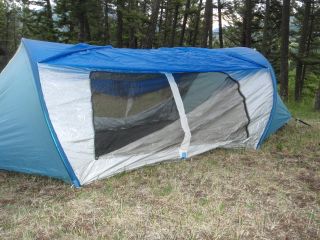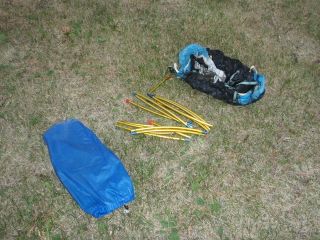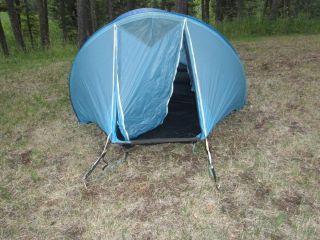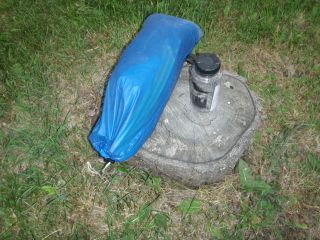

 |
 |
 |
Guest - Not logged in | |||||||||||||||||||||||||||||||
Reviews > Shelters > Tents > Stephensons Warmlite 3R Tent > Owner Review by Richard LyonStephenson's Warmlite 3R Tent
Owner Review by Richard Lyon August 4, 2013 Personal Details and Backpacking Background
Male, 67 years old Height: 6' 4" (1.93 m) Weight: 200 lb (91 kg) Email address: Montana DOT angler AT gmail DOT com Home: Bozeman, Montana USA I'm in my fifth decade of backpacking, now undertaken mostly in the Northern Rockies where I now live. I do a weeklong trip every summer, and often take three-day trips. I'm usually camping in alpine terrain, at altitudes 5000 to 13000 ft (1500-4000 m). I prefer base camp backpacking, a long hike in with day trips from camp, but I do my share of forced marches too. I’m always seeking ways to reduce my pack weight, but still usually choose a bit more weight over foregoing camp conveniences I've come to expect. One such convenience is a walled and floored tent. PRODUCT DETAILS  The
Warmlite 3R is a hybrid double-walled, four-season, tunnel-style
three-person mountaineering tent with a door but no separate vestibule
at each end. Its manufacturer isn't exactly modest about its
Warmlite tents, calling them "the lightest most storm resistant tents
you can find in the world. Featuring an aerodynamic design to reduce
wind load stress to the tent. Easy to setup and take down." The
Warmlite 3R is a hybrid double-walled, four-season, tunnel-style
three-person mountaineering tent with a door but no separate vestibule
at each end. Its manufacturer isn't exactly modest about its
Warmlite tents, calling them "the lightest most storm resistant tents
you can find in the world. Featuring an aerodynamic design to reduce
wind load stress to the tent. Easy to setup and take down." Five years ago I submitted an Owner Review on this site describing a Warmlite 2R, a smaller but similar tent from Stephenson’s. I encourage readers to peruse that Review before reading on below, as there I described a number of items common to all Warmlite tents and some of this iconic company’s design features and philosophy. Anything in this Review noted as “new” or a “change” refers to a change from things in 2003, when my Warmlite 2R was manufactured. Manufacturer: Stephenson's Warmlite, Gilford, New Hampshire USA Website: www.warmlite.com All quotations in this review come from this website. Year of manufacture: 2010 or so Year of purchase: 2011 (I bought it used.) MSRP: $625 US for base tent, see table below for options. For the tent I bought, $699. As I would configure a 3R the total cost would be $764. See comment below under “Ordering” for a standard discount. Length, listed: 134 in (3.4 m); measured: main tent section 66 in (170 cm); each end section 35 in (99 cm). Each of these was measured down the center of the tent. Total 136 in (3.45 m) (Note: To some extent the length depends on the tent pitch, as discussed below.) Width, listed and measured: 60 in (152 cm) Height, listed 41 in (104 cm), measured 40 in (102 cm) Packed size, listed and measured: 5 x 17 in (13 x 43 cm) Weight: listed 4 lb 5 oz (1.38 kg) (3 lb 12 oz/1.24 kg for tent + 5 oz/142 g for windows) + 4 oz/113 g for large doors; measured 4 lb 7 oz (1.42 kg). Measured weight includes standard two poles and stuff sack but not stakes.  Includes:
Tent, two shock-corded aluminum poles, a tube of seam sealant, and a
stuff sack. Note that Stephenson’s does not supply tent pegs. A
company spokeswoman explained that Stephenson’s had found that its
customers desire different types of stakes, so the company wouldn’t add
to its price by including a stock stake. Includes:
Tent, two shock-corded aluminum poles, a tube of seam sealant, and a
stuff sack. Note that Stephenson’s does not supply tent pegs. A
company spokeswoman explained that Stephenson’s had found that its
customers desire different types of stakes, so the company wouldn’t add
to its price by including a stock stake.Materials: Tent, "Ultra high tenacity 30d. ripstop Nylon with a very durable silicone waterproof finish." Nylon thread. 7187-T6 aluminum poles. Vents and windows, "the finest 'Noseeum' netting available." YKK zippers. Color: Light blue. See Ordering section below regarding color choice. Related Products: Warmlite tents are available in three sizes and three different configurations. The size designation refers to intended capacity: 2, 3, or 5 campers. R (for “reflective”) means a reflective inner wall between the two end poles; this is more or less the standard tent. X means no inner wall, a single-wall tent. C is a tent in a climber’s (or ultralighter’s) version, two feet/62 centimeters shorter than a standard R and available in either R or X configuration. Size 5 is a larger version of the 3; size 2 has only one door and tapers down toward the closed end, as pictured in my earlier Owner Review. Ordering: Since my earlier Review Stephenson's has entered the e-commerce world to the extent that a customer may purchase its products through the website. (The site and telephone orders remain the only means of ordering; the company still has no distributors.) A buyer can save time and money by ordering one of the tents then in stock – Stephenson’s offers a ten per cent discount and the buyer avoids a “6-8 week” lead time needed to make up an order. Options: A buyer who wishes to customize her tent may choose among the following options.
Many
of the tents in stock the one time I inquired had large doors and side
windows. I learned after buying a used 2R that neither of these two
options can be retrofitted. I comment below on the three options on my
3R: large doors and side windows, which I have, and mid pole, which
I’ve recently ordered.
Color is definitely an option. Both my Warmlite tents were boring monochrome, the 2R in yellow and the 3R in light blue. My earlier Owner Review lists a buyer’s color choices and Stephenson’s cheerful urging to “Be creative.” Stephenson’s fabric is silnylon used in parachutes, hot air balloons, and spinnakers – if you want it colorful, Stephenson’s will oblige. PITCHING THE 3R It’s easy, pretty much the same as described in my Owner Review of the 2R, even though the chatty and unhelpful instructions have departed Warmlite’s website. After connecting the shock-corded poles I stake out a corner at one end of the tent. Then I thread the poles through their sleeves, making sure the pole end is seated inside the sleeve, and stretch the tent at both ends and stake out ten spots: each tent corner, each guy on the doors, and at each end of the mid-pole sleeve. I try to have one end of the tent dead-on windward, usually facing west, to minimize the impact of the wind on the tent’s structure. As with the 2R this is a tunnel tent and definitely not freestanding, and the end guys are imperative to maintain the shelter’s integrity. After some experimentation I think angling each end pole about 15 degrees forward from the vertical (away from the tent body) gives the most efficient and sturdy pitch. Level ground really helps too. The guys may be adjusted with a slider to compensate somewhat, but I’ve found it more difficult to maintain the forward lean when going uphill or downhill even a bit. I have found that using pegs with a shepherd's crook on top help considerably on the guys, which often are jostled when entering or leaving the tent. Incidentally, Stephenson’s continues to use its contrarian fat poles, at 5/8 in (16 mm) about twice the diameter of “standard” tent poles. FIELD CONDITIONS I have used the 3R on fall, winter, and summer backcountry trips. Its maiden voyage took place last October on a three-day, two night trip in Yellowstone National Park, Wyoming. Temperatures varied from about 70 F (21 C) during the day to slightly below freezing at night. A short rain squall during the first afternoon but no precipitation when the tent was pitched. Both mornings were well below the dew point and there was a mixture of frost and dew everywhere. I pitched the tent on forest duff. Next came an overnight in early November on along the Blacktail Divide trail, also in Yellowstone Park. Again the Warmlite but with a major addition to my sleep system. Though clear except for a few minor snow flurries and with little wind it was very cold, -3 F (-15 C) at the trailhead dropping to -15 F (-25 C) early the following morning. The snow cover was light enough to be able to pitch the tent on very hard ground, in the open. Most recently I slept in the 3R on a weeklong backpack service trip in the Scapegoat Wilderness in Montana’s Rocky Mountain Front. Nighttime temperature dropped to 40-45 F (4-7 C) at an altitude of about 5500 feet (1700 m). No precipitation all week, but some high winds on two nights and often late in the afternoon. Our group pitched our tents in a large meadow near the confluence of Telephone and Cave Creeks, just off a stretch of the Continental Divide Trail. The soil was dry, hard, and full of rocks and scrub. Spring use has been limited to one car-camping overnighter in Paradise Valley, Montana in late March. Nighttime temperatures dropped to about 20 F (-7 C) in March, with no rain and no significant wind. I pitched the tent on hardpacked dirt. PERFORMANCE Features. Let’s start here, as two of the options on my 3R are new to me and the third has been upgraded since my earlier Owner Review.  The large doors,
included at both ends of my tent, make ingress and egress considerably
easier by increasing open door space to a door’s full size, 21.5 x 37
inches (55 x 94 cm). Each side of the door has its own pair of
zippers so that it’s very easy to close up the tent from inside or
outside. A big improvement for a big guy over the standard door on my
2R, the large door is one feature I would definitely pay extra for if I
ever order another Stephenson’s tent. The inside zipper runs along the
bottom of the door to allow full closure if the local mosquitoes are
especially ferocious. This zipper is easily accessible from the outside
too. Each door has a triangular vent at the top and a small strip of
netting at the bottom. The large doors,
included at both ends of my tent, make ingress and egress considerably
easier by increasing open door space to a door’s full size, 21.5 x 37
inches (55 x 94 cm). Each side of the door has its own pair of
zippers so that it’s very easy to close up the tent from inside or
outside. A big improvement for a big guy over the standard door on my
2R, the large door is one feature I would definitely pay extra for if I
ever order another Stephenson’s tent. The inside zipper runs along the
bottom of the door to allow full closure if the local mosquitoes are
especially ferocious. This zipper is easily accessible from the outside
too. Each door has a triangular vent at the top and a small strip of
netting at the bottom.As with the 2R, I love the side windows, which when open really aid ventilation. Whenever I returned to camp on a warm day I found the fully zipped-up 3R stiflingly hot and humid. Stephenson’s fabric is not breathable, and the mid-tent aluminum liner acts as a heater when exposed to direct sunlight. That’s one reason Stephenson’s recommends pitching a Warmlite in the shade. (Avoiding deterioration of the fabric from extended UV exposure is its main reason.) That wasn’t possible on my recent service trip, and I was grateful for the breeze once I returned to camp and opened the windows. In my opinion the side windows are necessary features even if tent use is limited to winter climes. A buttoned-up inside gets damp as well as hot; there’s nowhere for the accumulated condensation to evaporate. Leave the windows open just a bit at the bottom, however, and the inside condensation evaporates nicely. My usual solution in the Rockies is to leave the inside windows open about halfway up and the outer windows a few inches/centimeters up from the bottom. This hasn’t allowed rain inside and has kept the interior ventilated and relatively dry. The side windows differ somewhat from those on my 2R. The rock sacks are gone, and the miniscule loops at each corner have been replaced with larger ones – large enough easily to fit over the tip of a trekking pole and easily fitted with string for tying them over the top of the tent in any configuration suits my fancy. Both these changes are in my view very useful upgrades. The prior owner of my 3R didn’t buy a mid pole. I have always used the tent without one and I agree with Stephenson’s that it’s not needed for strength, at least in the conditions I encountered. One of the problems with pitching the 3R, however, makes it nice to have. This tent has a large footprint and unless the ground is perfectly flat it can be difficult to maintain a taut pitch, particularly if the tent is buffeted by strong winds. With a slight loss of forward pole cant the middle tends to sag. Not enough to make me claustrophobic but enough so that I can’t sit up without brushing my head on the ceiling. To me it’s worth the extra five ounces (142 g) to avoid it, so I have ordered one. Standard features are few, as might be expected in so lightweight a tent. Each corner of the main tent body has a mesh pocket, 5 by 8 inches (13 by 20 cm). A string runs across the top of the ceiling ridge; I have on occasion hung a lantern from it. Vents at the top and bottom of each door allow some adjustment for warmth or ventilation. That’s about it. Stephenson’s brags that its tents’ vestibules are floored to keep gear dry. What the company refers to as a vestibule is inside the tent doors and not separated from the sleeping chamber, so I say it’s part of the tent. I would never use it for cooking because of ventilation issues and fire risk – Warmlite tents are highly flammable. I rarely cook in a vestibule anyway and I do like the extra space inside the tent for storage. Space and capacity. This is a large tent in every respect, particularly given its measly weight. Normally (properly pitched, no sag in the middle) three adults and a child can sit up comfortably. Two adults and a child had no difficulty or unwanted contact inside, sleeping side-by-side, with plenty of storage room for gear and sufficient headroom for two to dress at the same time. For two adults it’s a condo – not even any disturbance when my tentmate needed to answer nature’s call in the middle of the night. I do like the additional space inside the tent’s four walls, particularly for boot storage. Strength and Durability. The 3R is tough as well. I’ve yet to use a ground cloth, even on the car camping trip, and the most recent service trip required camping in a meadow filled with rocks, briars, and nettles. Stephenson’s silnylon came through without even a scratch. That trip also included three spells of serious wind that managed to collapse almost all of the other tents in camp. The only problem I had was a brief loss of one tent peg, and upon examination it was clear that a badly dented and misshapen peg or the owner’s careless pitch, not the tent, was to blame. As the peg had anchored a guy at one end, that portion of the tent had sagged almost to the floor. A quick (and this time careful) re-staking took care of the problem. The next morning, strictly as a precautionary measure, I removed all four guy stakes, folded the front sections down over the tent, and weighted each corner with a rock. Returning to camp after work I re-pitched the guys, an operation that lasted two minutes at most. I’ve not had the pleasure of weathering a heavy rainstorm inside the 3R. Neither snow flurries nor heavy dew penetrated the fabric at the single- or double-wall portion, and a water spill inside the tent beaded and then puddled up quickly. Based on this any my experience with the 2R I’m not concerned with this tent’s ability to keep out the elements. Ventilation. This is the one category in which Stephenson’s and I may respectfully disagree. As with my 2R, I’ve had some condensation issues with the 3R, and I’m reasonably certain these problems are endemic to Stephenson’s use of its parachute nylon for its tents’ outer fabric. Most mornings when I awaken in this tent, usually about 5.30 AM, I’ve noticed significant condensation on the inner tent walls. This phenomenon occurs regardless of outside temperature or humidity, though it’s worst when it’s above freezing but below the dew point, as occurred two nights on the recent service trip and each night last fall. There are several possible culprits. I quickly dispense with any fault in the tent’s design or ventilation system, as all condensation dries incredibly quickly after the tent’s occupants get going in the morning, and besides condensation didn’t happen in the afternoons when I return to camp. Nor do I blame my own failure properly to set the ventilation adjustments before retiring to bed. To avoid too much heat on summer nights I’ve been careful to leave the inside window zippers open and to allow some flapping of the outer window panels and improve airflow. No, I think this is something that goes with use of non-breathable fabric in a tent. Stephenson’s seeks to avoid this by recommending that the sleepers use a vapor barrier, clothes or bag a bag liner, to reduce the condensation output from inside the tent. (In fact it’s vapor barrier liners only that the company endorses. Not only does Stephenson's sell a "Triple Bag" that includes such a liner, its founders are longtime naturist advocates who condone only one way to sleep in a sleeping bag – naked.) Not ever having tried this preferred alternative I can’t say if it’ll cut back on condensation or not. Rather I take some, often more than a little, condensation as a fact of life in the 3R.  The
amount at issue isn’t too bad. Certainly it’s not enough to disqualify
the tent from warm weather use, and it’s not really much worse than
what I’ve experienced in my one other double-wall tent (which has a
waterproof-breathable fabric) in summer. But I do need to be careful
first thing in the morning. The
amount at issue isn’t too bad. Certainly it’s not enough to disqualify
the tent from warm weather use, and it’s not really much worse than
what I’ve experienced in my one other double-wall tent (which has a
waterproof-breathable fabric) in summer. But I do need to be careful
first thing in the morning.Whenever the nighttime temperature dropped below freezing a small amount of frost accumulated on the top vents. Even on the sub-zero F (-17 C) night it wasn’t enough to block circulation. Care. Nothing special is required. As with my other tents I hose down the 3R every now and then, and spot clean bird droppings and other surface dirt. Once I’ve bathed it in a MiraZyme solution for protection against mildew. I haven’t seam-sealed the 3R but may do so this winter. As noted Stephenson’s recommends pitching the tent out of direct sunlight, and I try to do that whenever possible – though the tent’s sizable footprint and the need for flat ground can sometimes make compliance difficult. Summary. The Warmlite 3R is an excellent tent for all seasons. I’m glad I bought it. WHAT I REALLY LIKE Easy to pitch, strike, and pack. As easy as a single-wall tent. Plenty of room. Especially welcome to this claustrophobic camper. Weatherworthy and durable. Prompt, friendly, and first-rate customer service. MY LESS FAVORITE THINGS The large footprint (more than 11 ft/1.4 m) and need for level ground for a stable pitch complicate finding a suitable tent site. Freestanding tents remain my preference. Condensation issues. Probably because I’ve been spoiled by Bibler tents. The “modern” website. There’s no functional loss, but reading the chatty, opinionated old one was always good for a smile. Still available if the reader (if over eighteen years of age) may order a paper catalog or download a .pdf version. Read more reviews of Stephenson gear Read more gear reviews by Richard Lyon Reviews > Shelters > Tents > Stephensons Warmlite 3R Tent > Owner Review by Richard Lyon | ||||||||||||||||||||||||||||||||